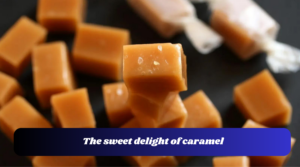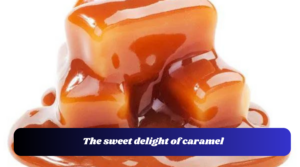Although caramel hasn’t been around since the beginning of time, it’s possible that humans have been able to make it ever since they discovered how to cook with fire.
It is believed that sugar cane juice was heated in India about the year 250, and the resulting caramelized sugar was then used to make sweet candies.
The name “caramel” originates from the Latin phrase “canna melis,” which refers to the sugar cane that is used in the production of caramel.
It first arrived in Persia, which is now known as Iran, then made its way to Greece and Rome before spreading throughout Europe.
It is thought that the Egyptians experimented to make an energy-dense food that was simple to handle and transport about the year 1000 AD, and one of their successes was the creation of the first solid caramel. The end product resembled something very much like a hard-boiled candy to our way of thinking.
In the meantime, it is believed that Indonesia was the first country to manufacture a caramelized sweetened milk in the 1500s.

After then, Spanish explorers brought it to the Americas about the same time that colonizers brought sugar cane and livestock that produced milk to Latin America. The end product was a substance that is now generally referred to as dulce de leche. These five countries—Uruguay, Argentina, Chile, Colombia, and Peru—all take great pride in asserting that they were the ones who first developed this delicacy.
In addition, there is evidence that American settlers in the 1650s produced a boiled caramel candy that included milk and fat in order to produce a chewier caramel candy. This evidence dates back to the time period.
A fast forward to the present day reveals that caramel is still cherished in many parts of the world and plays an important role in our culinary heritage. We consume it and use it to flavor and color our food. Since the 1800s, it has been used in breweries to make beer, and it may be found in a wide variety of dishes, from soda to sauces and desserts.
In point of fact, it is the food coloring that is used the most by weight all over the world.
According to the Innova Market New Products Database, the flavor of caramel, which includes salted caramel, has been the highest-ranking flavor in new product releases in the chocolate confectionery industry in Australia and New Zealand over the course of the past 12 months. It holds the number two spot in the Desserts and Ice Creams category, and the number four spot in both the Dairy and Non-Dairy Yogurt sections.
Because of caramel’s adaptability, manufacturers can combine it with other flavors to create really delectable eating experiences across a variety of product categories by using a combination of caramel and those other flavors.
One of the reasons for its widespread appeal is that it may satisfy a wide variety of gastronomic preferences. There are goods available such as Cadbury Caramilk, flavors with salted caramel or toffee, and white chocolate that are sweeter than other selections. Desserts that have a component of burnt caramel, dark chocolate combinations that include salted caramel, and caramel/nut liqueurs are all options for people with more developed palates.
The caramel transformation
Caramel is essentially just sugar that has been burned. Consider the process of making caramel by heating butter and sugar in a skillet to create a sauce that can be used in classic European caramelized potatoes or in homemade muesli.
Caramel colors are created by using straightforward sugars like glucose, fructose, or sucrose. These sugars are referred to as carbohydrates because the molecules of their molecules comprise carbon, hydrogen, and oxygen atoms that are bonded together by covalent bonds. (The fact that covalent bonds include the sharing of electrons maintains the attraction between the bonded molecules.)
When these molecules are heated during the process of caramelization, the atoms inside them rearrange and mix, resulting in the production of bigger carbohydrates (polymers), water vapor, and volatile chemicals. These are the molecules that are responsible for the enticing aroma of caramel.
The production of caramel is a difficult process that involves the production of hundreds of molecules and their interaction with one another. The temperature and the type of carbohydrate used in the process play a significant role in determining which polymer is produced.
Any final caramel color product, regardless of its nature, does not match to a mixture of essential elements that can be precisely specified. During the process of cooking, it undergoes a progression that causes it to evolve in all of its complexities. Because of this, the making of caramel can be considered both a scientific and an artistic endeavor in many respects.
Since 1968, Oterra has established itself as a leader in the caramel industry. Oterra’s experts have been able to apply this information to improve Oterra’s caramel products. Over the course of the past 50 years and more, significant progress has been made in the understanding of the numerous compounds created when sugar is burned.
In point of fact, Oterra is one of the world’s major providers of the brown color derived from caramelized sugar and possesses one of the most comprehensive product lines consisting of brown colors derived from caramel.
These hues range from yellow to a brown that is more reddish to a dark brown that is almost blackish in appearance. The production process and the use for which the color is intended both influence the colloidal charge that the color possesses. In order to avoid problems with precipitation and mist, for instance, beer needs a color that has a positive charge, while soft drinks need a color that has a negative charge.









